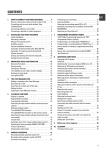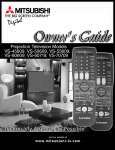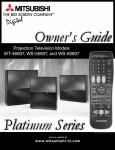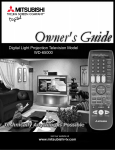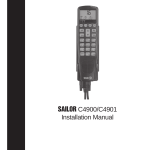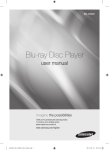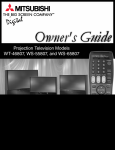Download Applied Wireless AT900-32 User`s guide
Transcript
User’s Guide Instructions for Installation and Operation 900 MHz Stereo Audio Transmitter Model AT900-32 900 MHz Stereo Audio Receiver Model AR900-32 Long Range Wireless Applications (This page intentionally left blank) 900 MHz Stereo Audio Transmitter Model AT900-32 900 MHz Stereo Audio Receiver Model AR900-32 Introduction / Product Descriptions Model AT900-32 from Applied Wireless, Inc. is a high quality transmitter designed to broadcast excellent quality low noise stereo audio from any line level source, to the Applied Wireless model AR900-32 receiver. The AT900-32 transmitter is compatible with line level audio sources such as CD and DVD players, commercial radio (AM or FM) receivers, satellite radio receivers, MP3 players, and PCs. Model AT900-32 conforms to FCC Part 15 requirements for unlicensed use, and will transmit over distances up to 750 feet.* The range may be increased substantially through the use of a directional antenna (such as a flat panel or Yagi) at the receiver. * Unobstructed, straight line-of-sight range, when used with the standard antennas included with the transmitter and receiver. The AT900-32 transmitter and the AR900-32 receiver provide thirty-two user-selectable channels of operation within the 902 – 928 MHz band to enable simultaneous operation of multiple transmitters in a common area. Excellent frequency stability is assured through the use of crystal references. The products incorporate precise FM modulation and sophisticated filters to provide stable, interference-free high fidelity audio reception. The transmitter and receiver are housed in small yet rugged aluminum extrusion enclosures. AC power converters (9VDC) are supplied, along with RCA phono-type audio cables. By FCC regulation, the transmitter’s quarter-wave antenna is permanently attached (substituting a different antenna, or mounting the antenna remotely are not permitted). The antenna supplied with the receiver is a removable quarter-wave ground plane (sometimes referred to as a half-wave) antenna. The receiver’s antenna User’s Guide – 900MHz Stereo Audio Transmitter & Receiver 1 attaches with a BNC connector, enabling the use of an alternative antenna, (such as a directional flat panel or Yagi) to increase operating range (please contact Applied Wireless for a selection of available antennas). The AT900-32 transmitter and the AR900-32 receiver are well-suited for many diverse applications, including distribution of audio entertainment content throughout a building, home theater installations, commercial and industrial surveillance, monitoring, security, etc. Installation Instructions Before Beginning the Installation Plan your installation carefully. The physical location and orientation of the transmitter and receiver antennas (relative to each other and their surroundings) will have a significant influence on reception quality at the receiver. The following guidelines will generally yield the best results: • • • • Both the transmitter antenna and the receiver antenna should be positioned vertically (pointing either up or down). Antennas should be positioned high enough to enable people to move about below them without creating obstructions between the antennas. Although the RF signal from the transmitter will pass through most non-metallic building materials (wood, stucco, brick, etc.), its strength is reduced with every wall through which it must pass. Therefore, maximum stated reception range is based on unobstructed line of sight conditions. The transmitter and receiver are both rated for indoor use only. If either unit must be located outdoors, it must be protected from the elements (using, for example, a non-metallic NEMA4 enclosure). Connecting Audio to the AT900-32 Transmitter Connect a line level stereo audio source (outputs from a CD player, for example) to the corresponding LEFT and RIGHT line-level input jacks on the transmitter’s rear panel (refer to Figure 1). A shielded dual cable is supplied with the transmitter for making these connections. Some audio devices, such as MP3 players, portable CD players, and PC sound cards have a single miniature (3.5mm) stereo phone jack (as opposed to separate 2 Applied Wireless, Inc. RCA phono-type jacks). To connect any of these to the transmitter, use the supplied adaptor in conjunction with the standard dual cable to make the connection. Figure 1 – AT900-32 Transmitter (Rear Panel) Note 1: If the audio source device provides only a single (mono) output, a “Y” adaptor (not supplied) may be used to feed the signal to both of the transmitter’s input jacks. Note 2: If a microphone is to be used as the audio source, an external microphone preamp (not supplied) must be used to raise the microphone’s output signal to the required line level. Connecting the AR900-32 Receiver’s Audio Outputs Using the shielded dual audio cable provided, connect the receiver’s line level audio outputs to the appropriate inputs on the device that is to amplify and reproduce (or record) the received audio signals (refer to Figure 2). If the destination device has only a single (mono) input, a “Y” adaptor (not supplied) may be used to combine the receiver’s LEFT and RIGHT outputs, and feed the combined signal to the destination device’s mono input jack. User’s Guide – 900MHz Stereo Audio Transmitter & Receiver 3 Figure 2 – AR900-32 Receiver (Rear Panel) Connecting Power to the Transmitter and Receiver The AT900-32 and the AR900-32 each require an external power source of between 7.5 and 18 volts DC. A plug-in 120VAC-to-9VDC power converter is supplied with each unit. Insert the power converter’s 2.1mm plug into the DC INPUT jack on the unit’s rear panel (refer to Figures 1 and 2). Plug each converter into a live 120VAC outlet. The transmitter’s red POWER indicator LED (on the front panel) should illuminate. On the receiver, power on is indicated by the illumination of the 2 digit CHANNEL display. User Settings and Adjustments Selecting the Channel of Operation (Transmitter) Referring to Figure 3 and Table 1, select the channel on which the transmitter will operate. Available channels are numbered 01 through 32. To select a channel, use a small flat-blade screwdriver to rotate the selector on the left to the “tens digit” of the desired channel, then rotate the selector on the right to the “ones digit” of the desired channel. As an example, to select channel 26 rotate the selector on the left to “2,” and rotate the selector on the right to “6.” Be sure to line up the selector’s triangle-shaped pointer (NOT the screwdriver slot) to the desired number. Please note that setting the channel to “00” is the same as channel “01.” Similarly, setting the channel to any number from “33” to “99” is the same as channel “32.” If several AT900-32 transmitters are to be used simultaneously in a common area (so as to broadcast multiple audio programs), each transmitter must be set to its own unique channel. 4 Applied Wireless, Inc. Set this selector to the “ones” digit of the desired channel Set this selector to the “tens” digit of the desired channel Figure 3 – AT900-32 Transmitter (Front Panel) Selecting the Channel of Operation (Receiver) The AT900-32 provides 32 user-selectable channels. Referring to Figure 4 and Table 1, use the DOWN and UP buttons on the unit’s front panel to select the desired channel. Momentarily pressing either button will raise or lower the displayed channel by one; holding either button continuously will rapidly cycle the channels up or down as appropriate. If multiple AT900-32 transmitters are operating in a common area to broadcast multiple audio programs, the AR900-32 receiver can receive any of the desired programs simply by selecting the corresponding channel. Figure 4 – AR900-32 Receiver (Front Panel) User’s Guide – 900MHz Stereo Audio Transmitter & Receiver 5 If you encounter sporadic noises, dropouts, fading, etc., it may be due to interference from another 900MHz device (such as an older cordless phone or baby monitor) operating nearby. To alleviate the problem, try selecting a different channel for the transmitter and receiver – ideally one that is at least 9MHz above or below the originally selected channel (see Table 1). Please note: Wireless devices that operate outside of the 902 – 928MHz frequency band, such as modern cordless phones and computer networks operating at 2.4 or 5.8GHz, will not generally interfere with, or be affected by, the AT900-32 transmitter and/or the AR900-32 receiver. Table 1 – Channel / Frequency Allocations Channel Number Frequency (MHz) Channel Number Frequency (MHz) Channel Number Frequency (MHz) Channel Number Frequency (MHz) 01 02 03 04 05 06 07 08 905.0 906.2 923.6 924.4 925.6 910.6 911.8 913.4 09 10 11 12 13 14 15 16 914.2 915.4 917.0 917.8 919.0 920.6 921.4 922.6 17 18 19 20 21 22 23 24 905.6 906.6 907.6 908.8 910.0 911.2 912.4 913.8 25 26 27 28 29 30 31 32 915.0 916.2 917.4 918.4 919.6 921.0 921.8 923.0 NOTE 1: Setting the transmitter to channel “00” is the same as channel 1. Similarly, setting the transmitter’s channel to any number from “33” to “99” (inclusive) is the same as channel 32. NOTE 2: If the AT900-32 and AR900-32 will be used along with an Applied Wireless video transmitter and receiver (models VT900-3 and VR900-3), the channel for the audio units must be at least 9MHz above or below the channel of the video units, to prevent interference between the RF signals. For example, if the video units are set to channel 1 (907MHz), set the audio units to channel 32. Setting the Transmitter’s Audio Modulation Level With an active audio source connected to the transmitter’s AUDIO INPUTS, adjust the AUDIO LEVEL control on the front panel such that the green MODULATION LEVEL OK indicator is illuminated whenever audio is present, and the red PEAK indicator flashes only on the loudest audio transients. To prevent distorted audio at the receiver, the red PEAK indicator should not be illuminated continuously. 6 Applied Wireless, Inc. IMPORTANT! Properly setting the transmitter’s modulation level is CRITICAL to satisfactory operation of the transmitter, and receiver. If the level is set too low, the receiver will likely be plagued with objectionable background noise (hiss). If the level is set too high, distorted audio and/or interference on adjacent channels is likely to result. Note: The audio source device may have a volume control that adjusts the level of the audio signal(s) being fed to the transmitter’s inputs. If your source device (e.g. MP3 player, portable CD player, or PC sound card) is so equipped, initially set that device’s volume control to its approximate midpoint. Then, adjust the transmitter’s AUDIO LEVEL control as described above. Use the following guidelines to “fine tune” the settings: • If the audio output at the receiver suffers from excessive background noise, the source device’s volume level is probably set too low. Increase the source device’s volume control a bit, and readjust the transmitter’s AUDIO LEVEL control accordingly. • If the audio output at the receiver is distorted, and/or if the transmitted audio program can be heard on (or interferes with) either or both of the channels adjacent to the selected channel of operation, the source device’s volume level is probably set too high. Reduce the source device’s volume control a bit, and readjust the transmitter’s AUDIO LEVEL control accordingly. User’s Guide – 900MHz Stereo Audio Transmitter & Receiver 7 Adjusting Headphone Volume (Receiver) If desired, stereo headphones or earbuds equipped with a standard 3.5mm mini-phone plug may be used with the AR900-32 receiver. Insert the plug into the HEADPHONE jack on the rear panel. The output level at this jack may be adjusted using the VOLUME control on the front panel. Note: The receiver’s VOLUME control only affects the volume at the headphone jack. It does not affect the volume at the receiver’s line level audio output phono jacks. EQualization (Receiver) When headphones or earbuds are used with the receiver, the EQ button on the receiver’s front panel may be used to select one of four preset audio equalization (tone) profiles, enabling you to select the audio response characteristics that you prefer. The chosen equalization profile only affects the audio from the headphone jack on the rear panel. The audio signals at the line level audio output phono jacks remain “flat” regardless of the equalization profile chosen for the headphones. Momentarily pressing the EQ button will cause the 2-digit CHANNEL indicator to display the current equalization profile. The four equalization profiles are as follows: • • • • E1: No Equalization (flat response) E2: Bass Boost E3: Treble Boost E4: Bass Boost + Treble Boost Pressing the EQ button again (while the display is indicating the equalization profile) will advance to the next profile. The 2-digit CHANNEL indicator will automatically revert to displaying the receiver’s current channel when the EQ button has not been pressed for two to three seconds. 8 Applied Wireless, Inc. Transmitter Connection Diagram For maximum range, the transmitter’s antenna must be oriented vertically. Rear panel of transmitter AC Adaptor Dual RCA phono jack to 3.5mm mini phone plug adaptor 3.5mm Stereo Output Jack Right Left Audio Outputs Audio Source Device with RCA phono jack outputs, for example: • CD player • DVD player • Tuner • Satellite radio receiver Audio Source Device with 3.5mm mini phone jack stereo output, for example: • MP3 player • Portable CD player • PC Sound Card User’s Guide – 900MHz Stereo Audio Transmitter & Receiver 9 Receiver Connection Diagram For maximum range, the receiver’s antenna must be oriented vertically. Rear panel of receiver AC Adaptor Left Right Audio Inputs Audio Playback (or Recording) Device with RCA phono jack inputs, for example: • P.A. Amplifier • Stereo Receiver • Audio Recorder 10 Applied Wireless, Inc. Internal Settings The AT900-32 transmitter and the AR900-32 receiver each have internal jumpers and/or switches (on their respective printed circuit boards) that are preset at the factory to provide the proper configuration for most applications. The following sections describe these settings, and provide guidelines for when it may be necessary or desirable to modify them. CAUTION! The AT900-32 transmitter and the AR900-32 receiver both contain sensitive electronic components on their respective circuit boards. These devices can be permanently damaged by static discharge if adequate anti-static procedures are not observed. Such damage is not covered by the Applied Wireless, Inc. Limited Warranty. Before attempting to modify any of the internal settings, discharge any static that may have accumulated on your body by touching a metal object or surface that is earth grounded, such as a cold water pipe. In addition, your work area should be as static-free as possible (for example, do not work in an area in which the floor is covered by nylon carpeting). In order to modify any internal settings, the unit’s circuit board must be removed from the enclosure, as follows: 1. Disconnect the power and audio cables from the unit. 2. For the receiver, remove the antenna. For the transmitter, the antenna is permanently attached. Do not attempt to remove it. 3. For the receiver, remove the VOLUME knob. 4. For the transmitter, remove the two Phillips screws securing the front panel. 5. For the receiver, remove the two Phillips screws securing the rear panel. 6. The two long edges of the circuit board are retained in lengthwise grooves along the inside walls of the enclosure. Gently slide the circuit board out of the enclosure. As you remove the circuit board, hold it by its edges only. 7. Once the internal setting(s) have been modified as necessary, reassemble the unit by reversing the steps above. User’s Guide – 900MHz Stereo Audio Transmitter & Receiver 11 Local/Distance (DX) Jumper (Receiver) The AR900-32 receiver has an internal jumper that determines the receiver’s RF sensitivity. The factory default position for this jumper is the Distance (DX) setting, configuring the receiver for maximum sensitivity. This is the appropriate setting for most applications (to allow for maximum reception range). However, if multiple AT900-32 transmitters are to be used in a common area (so as to broadcast multiple audio programs), and any are set to operate on numerically adjacent channels, there is a possibility of interference from one channel to the adjacent channel. Switching the jumper to the LOCAL setting on any receiver(s) that exhibit such interference may reduce or eliminate this interference. To do this, perform the following steps: 1. Locate the LOCAL/DX jumper on the circuit board. In its factory default position, the jumper connects the middle pin of the 3-pin group to the DX pin, leaving the LOCAL pin open. 2. Remove the jumper from its default position, and reinsert it such that it connects the middle pin to the LOCAL pin (leaving the DX pin open). 12 Applied Wireless, Inc. Noise Reduction (Transmitter and Receiver) The transmitter and receiver are each equipped with active noise reduction circuits that minimize objectionable background noise (or “hiss”) which might otherwise be noticeable during periods of silence, such as the pause between tracks on a CD. These circuits are normally enabled (factory default). However, if the particular audio source material has very few (if any) silent pauses, the noise reduction circuits may be turned off, to give the sound a somewhat “brighter” or “livelier” character. To de-activate the noise reduction circuits, locate the NR switches on the transmitter and receiver printed circuit boards. Slide the actuator of each switch to its NR OFF position. Note 1: Be sure to readjust the transmitter’s audio modulation level (as described on pages 6and 7) anytime the noise reduction circuits are either activated or turned off. Note 2: The noise reduction switches in the transmitter and the receiver must be set to match each other (either on or off), in order to maintain balanced audio frequency response. User’s Guide – 900MHz Stereo Audio Transmitter & Receiver 13 Technical Specifications AT900-32 Transmitter Operating Frequency (32 Channels) Operating Voltage Range Operating Current Audio Signal-to-Noise Ratio* Audio Frequency Response (+/-3dB)* Audio Channel (L/R) Separation (@ 1KHz)* Audio Distortion (@ 1kHzm +/-25KHz deviation)* Stereo Pilot Level RF Output Power Frequency Stability (over operating temp.range) FM Deviation Harmonic Suppression Antenna Output Impedance Operating Temperature Range Storage Temperature Range 902 – 928 MHz 7.5 to 18VDC 120 mA 78 dB 50 - 15,000 Hz 30 dB 0.3% -20 dBc 1 mW (0 dBm) +/-30 ppm +/-75 KHz -45 dBc 50 Ohms -20°C to +70°C -50°C to +150°C *Audio performance specifications are “end-to-end” characteristics, when used with Model AR900-32 receiver. AR900-32 Receiver Operating Frequency (32 Channels) Operating Voltage Range Operating Current Audio Frequency Response (+/-3dB, flat EQ)* Audio Channel (L/R) Separation (@ 1KHz)* Audio Signal-to-Noise Ratio* Audio Distortion (@ 1kHzm +/-25KHz deviation)* RF Input Sensitivity (30 dB SNR) IF Bandwidth Antenna Input Impedance Frequency Stability (over operating temp. range) Operating Temperature Range Storage Temperature Range 902 – 928 MHz 7.5 to 18VDC 140 mA 50 - 15,000 Hz 30 dB 50 dB 0.3% -106 dBm 180 KHz 50 Ohms +/-30 ppm -20°C to +70°C -50°C to +150°C *Audio performance specifications are “end-to-end” characteristics, when used with Model AT900-32 transmitter. 14 Applied Wireless, Inc. The following sections pertain exclusively to the Audio Transmitter, Model AT900-32: This product incorporates transmitter module FCC ID: QY4265 This device complies with Part 15 of the FCC Rules. Operation is subject to the following two conditions: (1) This device may not cause harmful interference and (2) This device must accept any interference received, including interference that may cause undesired operation. INSTRUCTION TO THE USER (required by the FCC) This equipment has been tested and found to comply with the limits for a class B digital device, pursuant to part 15 of the FCC Rules. These limits are designed to provide reasonable protection against harmful interference in a residential installation. This equipment generates, uses and can radiate radio frequency energy and if not installed and used in accordance with the instructions, may cause harmful interference to radio communications. However, there is no guarantee that interference will not occur in a particular installation. If this equipment does cause harmful interference to radio or television reception, which can be determined by turning the equipment off and on, the user is encouraged to try to correct the interference by one or more of the following measures: • Reorient or relocate the receiving antenna. • Increase the separation between the equipment and receiver. • Connect the equipment into an outlet on a circuit different from that to which the receiver is connected. • Consult the dealer or an experienced radio/TV technician for help. This equipment has been certified to comply with the limits for a class B computing device, pursuant to FCC Rules. In order to maintain compliance with FCC regulations, shielded cables must be used with this equipment. Operation with non-approved equipment or unshielded cables is likely to result in interference to radio and TV reception. The user is cautioned that changes and modifications made to the equipment without the approval of manufacturer could void the user’s authority to operate this equipment. User’s Guide – 900MHz Stereo Audio Transmitter & Receiver 15 ONE YEAR LIMITED WARRANTY (USA) Products manufactured by APPLIED This warranty is extended to the original WIRELESS, INC. (AW) and sold to purchasers purchaser of the product(s) only, and is not in the USA are warranted by AW according to transferable to any subsequent owner or the following terms and conditions. You should owners of the product(s). AW reserves the right read this Warranty thoroughly. to make changes or improvements in its products without incurring any obligation to • WHAT IS COVERED, AND DURATION OF similarly alter products previously purchased. COVERAGE: • EXCLUSION OF INCIDENTAL OR AW warrants the product to be free from CONSEQUENTIAL DAMAGES: defects in materials and workmanship for one AW expressly disclaims liability for incidental (1) year from the date of purchase by the and consequential damages caused (or original end user purchaser. allegedly caused) by the product. The term • WHAT IS NOT COVERED: “incidental or consequential damages” refers This warranty does not apply to the following: (but is not limited) to: 1. Damage caused by accident, physical or 1. Expenses of transporting the product to electrical misuse or abuse, improper AW to obtain service. installation, failure to follow instructions 2. Loss of use of the product. contained in the User’s Guide, any use 3. Loss of the original purchaser’s time. contrary to the product’s intended • LIMITATION OF IMPLIED WARRANTIES: function, unauthorized service or alteration This warranty limits AW’s liability to the repair (i.e. service or alteration by anyone other or replacement of the product. AW makes no than AW). express warranty of merchantability or fitness 2. Damage occurring during shipment. for use. Any implied warranties, including 3. Damage caused by acts of God, including fitness for use and merchantability, are limited without limitation: earthquake, fire, flood, in duration to the period of the one (1) year storms, or other acts of nature. express limited warranty set forth herein. The 4. Damage or malfunction caused by the remedies provided under this warranty are intrusion of moisture or other exclusive and in lieu of all others. AW neither contamination within the product. assumes nor authorizes any person or 5. Batteries supplied by AW in or for the organization to make any warranties or assume product. any liability in connection with the sale, 6. Cosmetic deterioration of chassis, cases, installation, or use of this product. or pushbuttons resulting from wear and tear typical of normal use. Any cost or expense related to troubleshooting to determine whether a malfunction is due to a defect in the product itself, in the installation, or any combination thereof. 8. Any cost or expense related to repairing or correcting the installation of an AW product. 9. Any cost or expense related to the removal or reinstallation of the product. 10. Any product whose serial number or date code is altered, defaced, obliterated, destroyed, or removed. 7. 16 Some states do not allow limitations on how long an implied warranty lasts, and some states do not allow the exclusion or limitation of liability for incidental or consequential damages so the limitations or exclusions stated herein may not apply to you. This warranty gives you specific legal rights and you may have other rights which vary from state to state. (continued on next page) Applied Wireless, Inc. ONE YEAR LIMITED WARRANTY (USA), cont. • HOW TO OBTAIN WARRANTY SERVICE: If a product covered by this warranty and sold in the USA by AW proves to be defective during the warranty period AW will, at its sole option, repair it or replace it with a comparable new or reconditioned product without charge for parts and labor, when said product is returned in compliance with the following requirements: 1. You must first contact AW at the following address/phone for assistance: APPLIED WIRELESS, INC. 1250 Avenida Acaso, Suite F Camarillo, CA 93012 Phone: (805) 383-9600 If you are instructed to return your product directly to the factory, a Return Merchandise Authorization number (RMA) will be issued to you. 2. You must package the product carefully and ship it insured and prepaid. The RMA number must be clearly indicated on the outside of the shipping container. Any product returned without an RMA number will be refused delivery. 3. (a) (b) (c) In order for AW to perform service under warranty, you must include the following: Your name, return shipping address (not a PO Box), and daytime telephone number. Proof of purchase showing the date of purchase. A detailed description of the defect or problem. Upon completion of service, AW will ship the product to the specified return shipping address. The method of shipping shall be at AW’s sole discretion. The cost of return shipping (within USA) shall be borne by AW. User’s Guide – 900MHz Stereo Audio Transmitter & Receiver 17 Applied Wireless products are designed and manufactured with pride in the United States of America © Copyright 2007 by Applied Wireless, Inc. All rights reserved. Specifications subject to change without notice. APPLIED WIRELESS, INC. 1250 Avenida Acaso, Camarillo, CA 93012 Phone: 805-383-9600 Fax: 805-383-9001 Email: [email protected] www.appliedwireless.com Pub. # UG-ATR90032 Rev. date 03/07




















